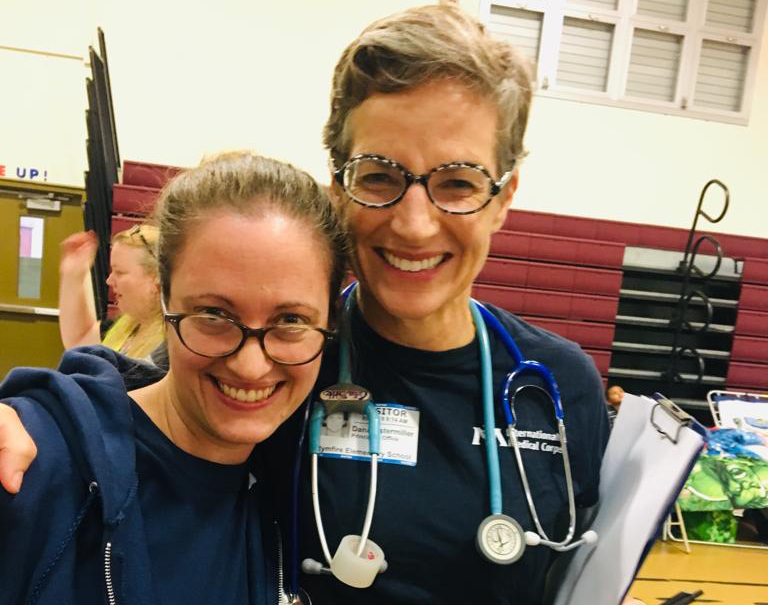In a fast-break humanitarian emergency, medical and healthcare volunteers form the lifeblood of an International Medical Corps response. They are selected from a roster of vetted professionals who have expressed interest in disaster response work, or from a partner professional group, such as the Registered Nurse Response Network.
Though they come with different skills and levels of experience in disaster response, they share one common goal: to apply their lifesaving skills to help survivors.
The diversity of this mix of professionals was captured in two volunteers who joined our response earlier this month to help survivors of Hurricane Dorian, a giant Category 5 storm that claimed scores of lives in the Bahamas alone and wreaked havoc as it cut a path of destruction extending thousands of miles from the Caribbean in the south to Nova Scotia in the north.
Dorian first looked as if it would make a direct strike on Florida’s Atlantic coast, prompting the state’s Department of Health to formally request International Medical Corps’ assistance under the terms of the Memorandum of Understanding we have with the state. As Dorian neared Florida’s coast, Dana Ostermiller, an experienced pediatrician on her first disaster response mission, flew in from her home in Paris, France, and was quickly assigned to head the night shift at an emergency special medical-needs center set up by the state to help those—mainly seniors—with mobility or other needs, such as portable oxygen or dialysis. The center was set up in an elementary school gym in the town of Palm Coast, northeast of Daytona, for those who felt unsafe in their own homes in hurricane conditions.
In addition to Ostermiller, the six-member medical team at the center included registered nurse Claire Liszkay, a Chicago native and disaster response veteran who has deployed to some 20 disasters on three continents over the past nine years. Her deployments have included some of the toughest and most dangerous relief missions in recent years, including the 2010 Haiti earthquake, the 2014–16 West African Ebola outbreak, and the ongoing refugee crisis in Bangladesh, focusing on minority Rohingya refugees who have been forced to flee persecution in neighboring Myanmar.
They and the other volunteers cared for the center’s more than 120 residents as the hurricane’s westernmost bands passed through area during the predawn hours of Sept 5. Even though Dorian stayed offshore, it brought with it powerful winds and rain. For this fragile group, it was still a scary event.
“For this particular group of individuals, it would have been an extremely difficult situation had they not been in a shelter,” said Liszkay. “There were quite a few folks who were anxious, afraid, especially when we lost power briefly.”
“We did a lot of reassuring,” noted Ostermiller.
A few days after shepherding the Florida center’s residents through Dorian’s near-miss, the two found themselves preparing for a far-larger challenge: joining International Medical Corps’ response in the Bahamas, where Dorian had stalled for almost two days as a dangerous Category 5 storm packing sustained winds of 185 miles per hour, with gusts as high as 220 mph.
Dorian caused catastrophic damage to the tiny island nation, in many places leaving little in its wake but debris. More than 75,000 lost their homes and with more than one thousand still missing, the final death toll is unknown.. As Liszkay and Ostermiller prepared to depart for the Bahamas, both said they felt fortunate to be chosen for such a challenging mission. Ostermiller, the less-experienced responder, added that she was nervous, but confident she was up to the challenge.
“I’ve been a doctor and been around patients for years,” she said. “Whether age 15 or 85, if a patient is suffering, I can respond. If I don’t have the answer, I’ll find someone who does.”
For Liszkay, it was a case of knowing in advance what lay ahead. “I’ve come to expect the unexpected,” she said, noting how her many deployments have also given her an enormous respect for the local health workers whom she has worked alongside in disasters’ wake.
“They are in the thick of it—with uncertainty often hanging over their own homes, communities and families—yet they’re willing to help those who need additional assistance,” she said. “That’s impressive. In comparison, it’s easy for me. I’m not wondering what’s happening in my house right now, but they are thinking about their kids, their pets, their home.”
She says she also enjoys the comradery engendered by disaster relief work, and the critical thinking skills required—to look at available resources, assess the needs and then connect the two. She also believes the work completes her as a person.
“I don’t think I’d be content not doing this,” Liszkay added. “I remember watching a report on Ebola several years ago and thinking, ‘I have the skills set, I have the time and am available, so it becomes a moral issue: Why would I not do this?’ I think this is some of the more important work I can do.”
For Ostermiller, her initial exposure to emergency humanitarian relief work has been an eye-opener—one that suggests her first deployment will not likely be her last.
“I’m rediscovering why I went into medicine in the first place,” she said about her initial work. “I’d say 95% of what I’m doing here is patient or colleague contact. For a clinician in the US, patient contact may be 60% of what you do. The other 40% is dealing with charts, calling insurance companies and tracking down lab results. It’s depleting.
“We want to be at the bedside, healing people, offering them comfort. That is what this is.”
